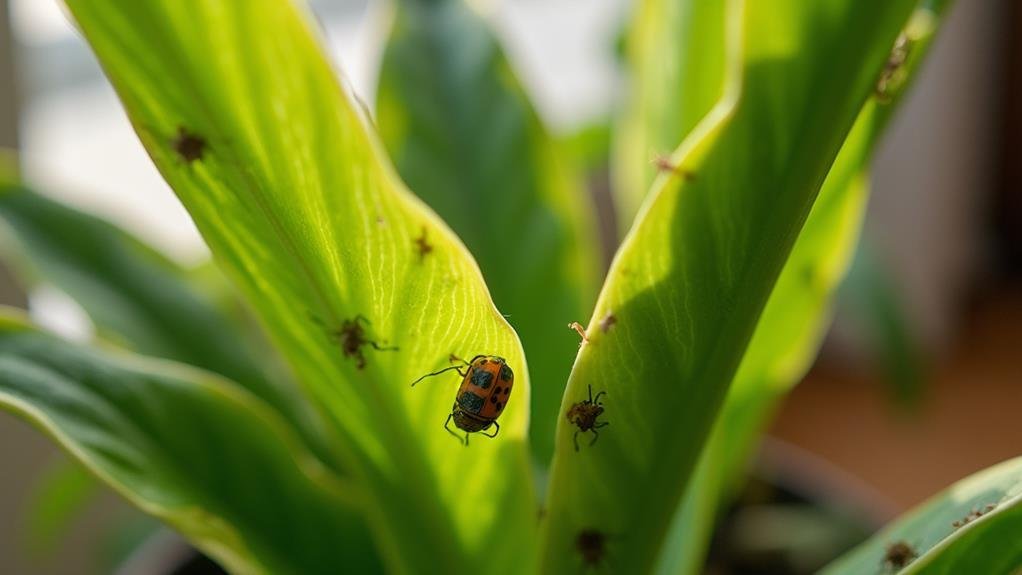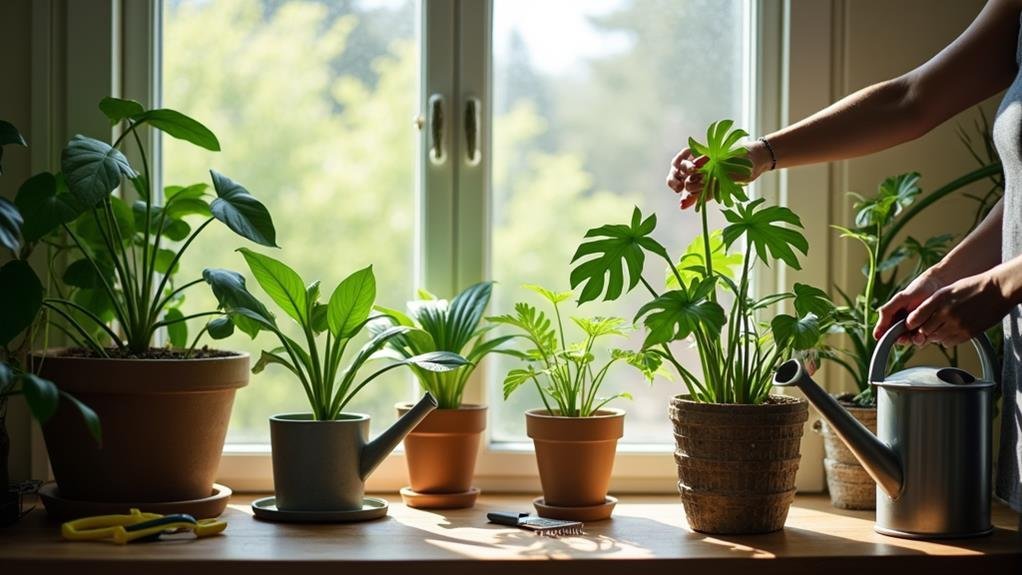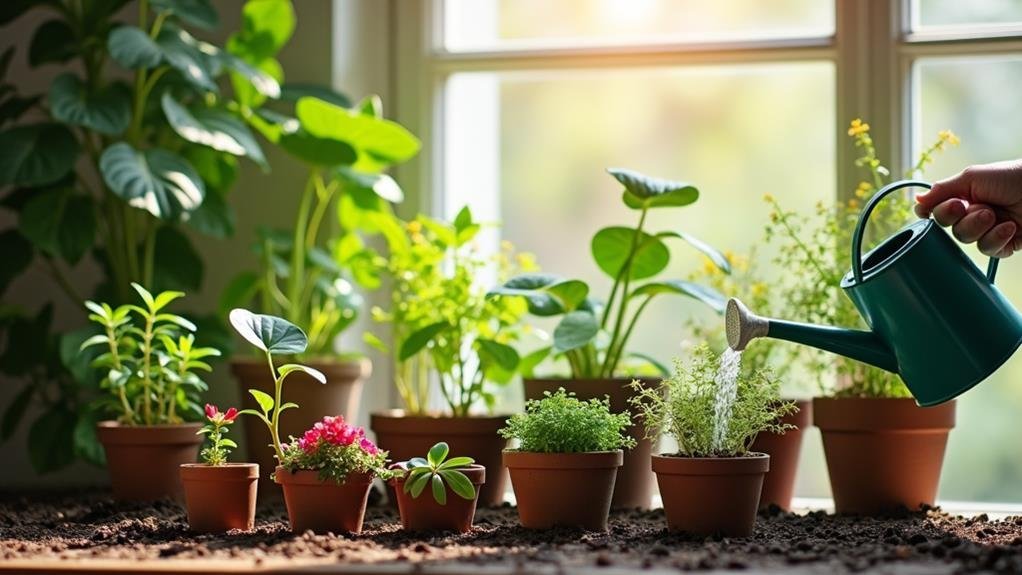Indoor plants can bring life to your space, but they often attract unwanted pests that can disrupt that harmony. You might find that factors like humidity, decaying leaves, and stagnant air are contributing to these infestations. It's vital to understand the causes behind this attraction to implement effective solutions. By maintaining proper care and utilizing natural methods, you can create a healthier environment for your plants. But what specific strategies can you adopt to keep these pests at bay and guarantee your indoor garden thrives?
Common Types of Indoor Pests
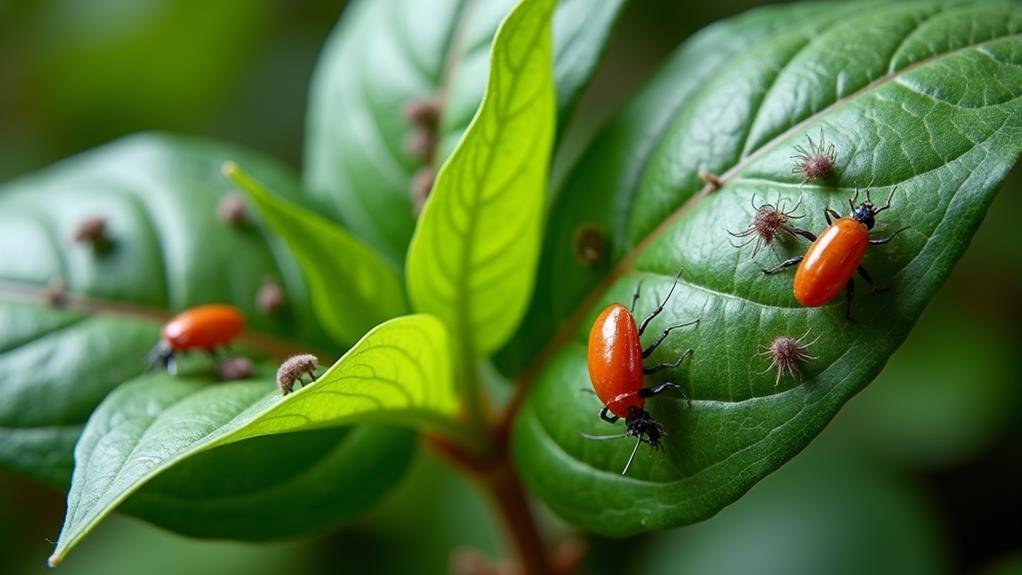
In the domain of indoor plants, pests can be a gardener's worst nightmare. You might encounter a variety of common pests that can wreak havoc on your beloved greenery.
One of the most frequent culprits is the spider mite. These tiny pests can cause significant damage by sucking the sap from your plants, leaving stippled leaves in their wake.
Another common intruder is the aphid, which can quickly multiply and overwhelm your plants. They tend to cluster on new growth, and their sticky residue can attract other pests.
Then, there's the fungus gnat, which thrives in overwatered soil. While adult gnats may be annoying, it's their larvae that can destroy your plant's roots.
Mealybugs are another unwelcome visitor, often found hiding in the leaf axils, and they produce a waxy substance that can inhibit your plant's growth.
Finally, scale insects can be hard to spot, but they attach themselves to stems and leaves, draining your plant's energy.
Signs of Pest Infestation
Pest infestations can be sneaky, often revealing themselves through subtle signs before they become a major issue. You need to keep an eye on your plants for any unusual changes that might indicate pests are taking up residence.
One common sign is yellowing leaves, which can signal stress caused by insects. If you notice sticky residue on the leaves or surrounding surfaces, it could be honeydew secreted by sap-sucking pests like aphids or mealybugs.
Another red flag is webbing, which generally indicates spider mites have moved in. You might also see tiny holes in the leaves or even a visible presence of pests, such as small bugs crawling on the plant.
Additionally, if your once-thriving plant starts to wilt or droop suddenly, it's time to investigate further—pests could be draining its energy.
Don't forget to check the soil, as some pests prefer to hide there. If you find small insects or larvae when you dig a little, act quickly.
The sooner you identify these signs, the better chance you have of keeping your indoor plants healthy and pest-free.
Causes of Pest Attraction
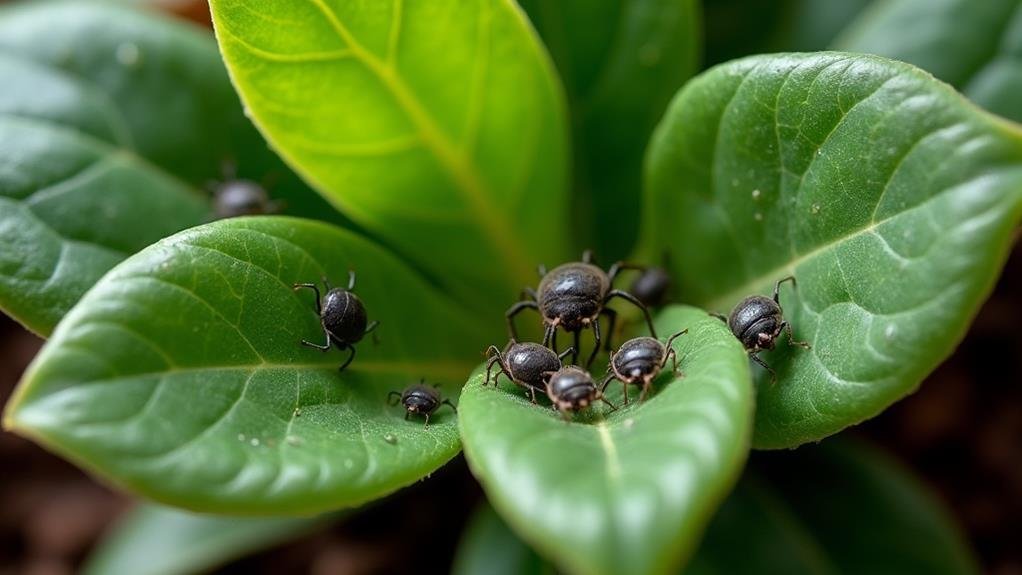
Identifying the signs of pest infestation is just the first step; understanding what attracts these nuisances is just as significant. Indoor plants create an inviting environment for pests due to various factors.
One major attraction is the presence of moisture. Overwatering your plants not only harms them but also creates a damp habitat that pests, like fungus gnats and spider mites, thrive in.
Another factor is the type of plant you choose. Some plants, particularly those with soft, tender leaves, are more appealing to pests than others. If you're drawn to those vibrant blooms or lush foliage, be cautious; they could come with unwanted guests.
Additionally, the accumulation of dead leaves or organic matter in the soil can provide a feast for pests, making regular maintenance essential.
Lastly, indoor environments often lack natural predators, allowing pests to multiply unchecked. Verify your plants are placed in a well-ventilated area with adequate light, as this can deter many common pests.
Understanding these causes can help you create a less inviting space for them, ultimately leading to healthier plants and a pest-free home.
Natural Pest Control Methods
A variety of natural pest control methods can help you keep your indoor plants healthy and thriving without the need for harsh chemicals. One effective approach is introducing beneficial insects, like ladybugs or lacewings, which feed on common pests such as aphids and spider mites.
You can also make homemade insecticidal soap by mixing water with a few drops of mild dish soap. Spray this solution directly on the affected areas of your plants to suffocate soft-bodied insects.
Another option is using neem oil, derived from the seeds of the neem tree. It disrupts the life cycle of pests and can deter them from infesting your plants. Just mix it with water and a few drops of dish soap, then spray it on your plants every few weeks.
Additionally, consider planting companion plants, such as marigolds or mint, which naturally repel pests. Keeping your plants clean by wiping their leaves with a damp cloth can also help prevent infestations.
Regularly checking for signs of pests guarantees you catch issues early. With these natural methods, you'll be well-equipped to maintain a healthy indoor garden.
Chemical Solutions for Pests

In the domain of managing pests in your indoor garden, chemical solutions can provide a quick and effective response. When you spot those pesky invaders, you might consider using insecticides, which target specific pests while minimizing harm to your plants. Always read the label carefully, as different products have varying active ingredients and application methods.
Another option is systemic pesticides, which you apply directly to the soil. These chemicals get absorbed by the plant, making it less appealing to pests. This method can be particularly useful if you're dealing with persistent issues. However, it's essential to verify that you're following the recommended dosages to avoid harming your plants.
Don't forget about sprays and powders that you can apply directly to the affected areas. These can help manage outbreaks quickly, but remember to check how they interact with your specific plants. After applying any chemical solution, it's wise to monitor your plants closely for any adverse effects.
While chemical solutions can be effective, you should always consider the potential impact on beneficial insects and the overall health of your indoor environment. Balancing effectiveness with safety is key to maintaining a thriving indoor garden.
Preventive Measures for Pests
Many indoor gardeners overlook the importance of preventive measures regarding pests. Taking proactive steps can save you time, money, and a lot of frustration down the line.
First, keep your plants clean. Wiping down leaves with a damp cloth removes dust and potential pests, allowing your plants to breathe better.
Next, guarantee proper air circulation. Overcrowding plants can create a humid environment where pests thrive. Give your plants enough space to grow and breathe.
You might also want to invest in yellow sticky traps; they're a simple way to monitor and catch flying pests before they become a problem.
Regularly inspect your plants for any signs of infestations, like discolored leaves or webbing. Early detection is key!
Additionally, consider rotating your plants. Moving them around can help prevent pests from establishing themselves in one spot.
Finally, avoid bringing in new plants without quarantining them first; this helps guarantee you don't introduce pests to your indoor garden.
Maintaining Plant Health
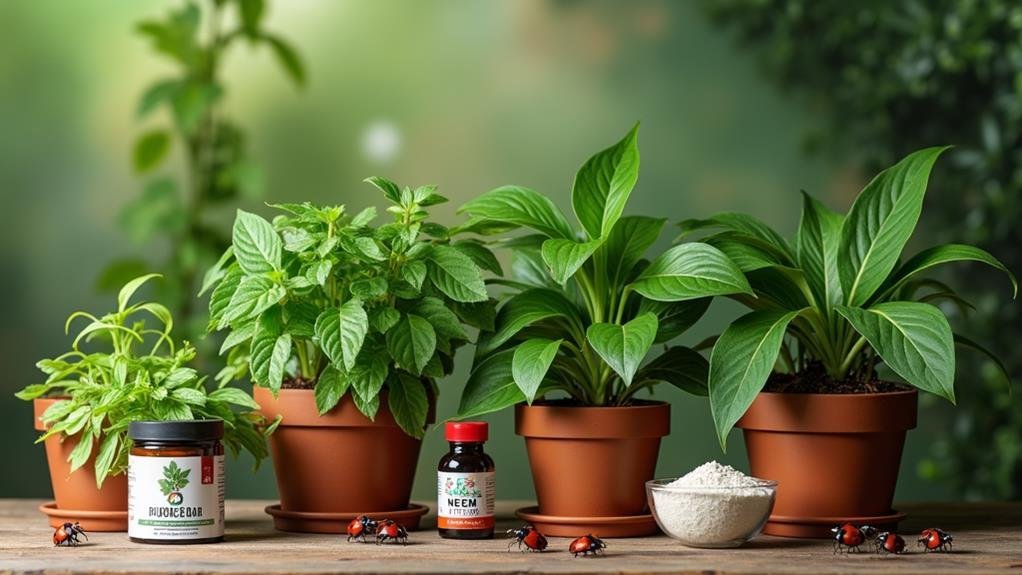
Maintaining plant health is crucial for a thriving indoor garden. Healthy plants are more resilient to pests, so focusing on their needs is key.
Start by ensuring your plants get the right amount of light. Each species has specific light requirements, so make sure you're placing them in ideal spots.
Next, monitor your watering habits. Overwatering can lead to root rot, while underwatering stresses the plant, making it more vulnerable to pests. A good rule of thumb is to check the soil moisture before watering.
Fertilizing appropriately also plays an important role. Use a balanced fertilizer during the growing season to provide essential nutrients, but avoid over-fertilizing, which can harm the roots.
Lastly, keep an eye on humidity levels. Many indoor plants thrive in higher humidity, so consider misting them or using a humidifier, especially during dry months.
Best Indoor Plants to Avoid Pests
Choosing the right indoor plants can greatly reduce the likelihood of pest infestations. Some plants naturally repel pests due to their scent or chemical composition. For instance, spider plants aren't only easy to care for but also deter common pests like aphids and spider mites. Likewise, lavender brings a lovely fragrance to your space while keeping pests at bay.
Another excellent choice is the peace lily. This plant thrives in low light and has air-purifying qualities, making it a favorite for many indoor gardeners. Plus, its natural properties can help repel flies and mosquitoes.
If you're looking for something a bit different, consider incorporating herbs like basil or mint. Not only do they add flavor to your cooking, but their strong scents also ward off pests like flies and aphids.
Lastly, rubber plants aren't just stylish; they're also resilient against pests. Their thick leaves make it harder for insects to settle.
While no plant is completely pest-proof, choosing these options can make your indoor garden a more inviting and pest-free environment. Enjoy creating your green oasis!
When to Seek Professional Help
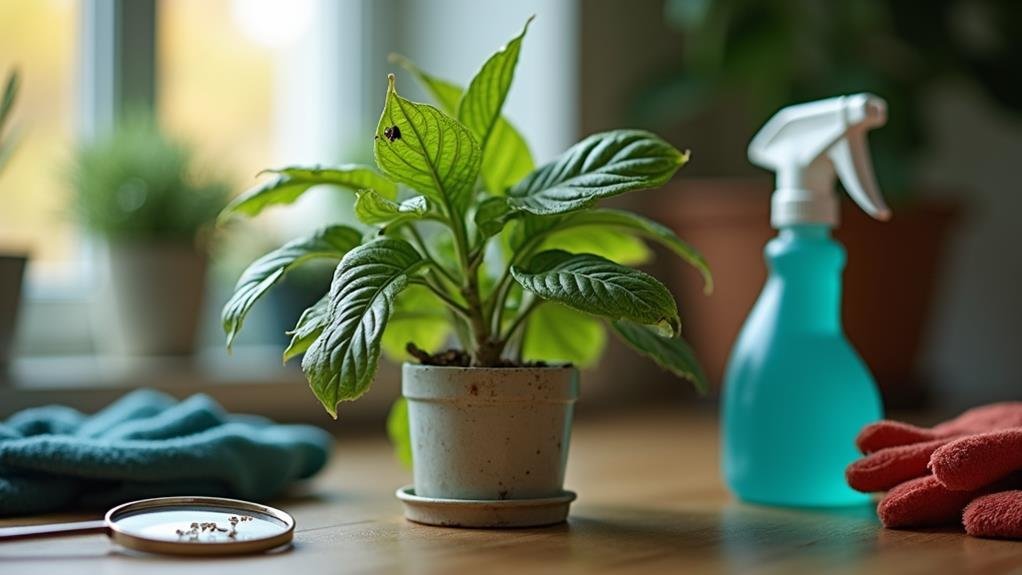
Recognizing when to seek professional help with pest issues can save you time and stress. If you notice a sudden explosion of pests on your indoor plants, it's a good idea to consult an expert.
While minor infestations might be manageable with DIY solutions, a significant outbreak often signals deeper issues that need professional intervention.
If you've tried various methods—like insecticidal soap or neem oil—and the pests persist, don't hesitate to call in the pros. They've the tools and expertise to identify the specific pests and recommend effective treatments.
Additionally, if your plants show signs of severe stress, such as wilting or yellowing leaves, this could indicate a larger problem that isn't just pest-related.
Professionals can help diagnose the issue and suggest appropriate steps to revive your plants.
Lastly, if you're dealing with a sensitive situation, like pets or children in the home, it's essential to guarantee that any pest control methods used are safe.
In these cases, professional help can provide peace of mind while effectively managing the pest situation.
Conclusion
To sum up, indoor plants can attract pests due to factors like moisture and debris. By recognizing signs of infestation and understanding the causes, you can implement effective natural or chemical solutions. Regular maintenance and preventive measures are key to keeping your plants healthy and pest-free. While some plants are more resilient, it's essential to stay vigilant. If problems persist, don't hesitate to reach out to a professional for assistance. Happy gardening!

